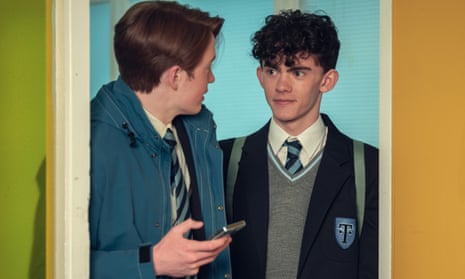No one came out as LGBTQ+ at my comprehensive in the north of England in the late 1990s for a very straightforward reason: it would constitute social death. Homophobia was the background hum of school life, a crude instrument to sometimes violently discipline any boy who deviated from rigid male expectations. Homophobia is, after all, the savage border guard of masculinity.
A geography teacher once mentioned a young boy who was outed years back, and suffered relentless abuse and violence until they were driven permanently from the school. It was a salutary lesson imprinted on my young brain. Shamefully I, too, occasionally laughed along at anti-gay innuendoes or lowlife gags about George Michael. Why risk suspicion with all it entailed? Half-victim, half-accomplice, like everyone else, as Jean-Paul Sartre put it.
I found it impossible, then, not to be moved by Netflix’s new school drama Heartstopper, which should be considered one of the most important LGBTQ+ shows ever made. It’s important to stress that it was not made for a geriatric millennial like me. It is squarely aimed at teenagers, which is one reason it is so pivotal. Written by the stunningly talented 27-year-old queer author Alice Oseman, it features a young geeky gay boy who falls for a rugby jock who, it transpires, is bisexual. Representation is at its core, with lesbians and queer people of colour – including a young trans woman who has transferred to the girls’ school – as key protagonists.
Many queer older millennials have been dazzled by the show, but also felt a sense of grief and loss at what they never had: either acceptance from our straight peers, or affirming representation on our television screens. I grew up in the age of section 28, which prohibited the so-called “promotion” of homosexuality in schools and in practice stifled all discussion of LGBTQ+ issues. The one exception I recall was a teacher warning against anal sex. As someone who didn’t come out until I was 20, what was so terrifying in adolescence was the sheer loneliness of the closet.
Heterosexuality offered a stable lifelong route map: find a life partner, marry, settle down, have children. With that seeming – however inaccurately – to be unattainable, what remained? The constant terror of rejection, of falling for straights who could never reciprocate, of suppressing your real identity for an easier life or to protect yourself from violence? Life is a tough enough gig, and brutally I did not want the hassle. I clung on to a passage from one of those “how to grow up” books which suggested that same-sex attraction was a temporary phase, that for many it would soon vanish.
LGBTQ+ cultural representation was weak at this point, and that compounded my loneliness. In popular culture, you could either find one-dimensional desexualised caricatures, or stories of tragedy – the shadow of the HIV/Aids pandemic was inescapable. Queer people living and loving, finding acceptance and yes, confronting challenges like anybody else and seeking to overcome them, was what was lacking.
This is why Heartstopper is so important. Some straight people may also look enviously at this show: regardless of sexual or gender identity, adolescence for many is defined by boredom, tedium, rejection and sometimes trauma. Most of us do not skip into the sunset with the rugby jock, after all. But at least straight people do not lack affirming representation on their TV screens. Young LGBTQ+ people now have a show with relatable and frankly adorable characters who face hardship, but who also have the possibility of happiness. Because of that, this show will be a lifeline for many.
Here’s a show, too, which reflects the transformed social values of generation Z – the zoomers who, I believe, will in time save us all, if there is a planet left to save. They are not free of problems, including homophobic bullying – as Heartstopper portrays – but they are the most progressive generation yet. Thanks in no small part to the struggle of LGBTQ+ people before, they feel more at ease with questions of sexuality and gender identity – something reflected in polling that shows only 54% of generation Z are attracted exclusively to the opposite gender, compared with 81% of boomers.
With Britain in the grip of a moral panic that depicts trans people as a potential threat to women and young people, positive cultural representation has never been more vital. The anti-gay rhetoric of the past damaged an entire generation. We don’t need to repeat the same mistakes.
But those often terrified young trans folk have a show in which one of their own is loved and affirmed, helping to puncture that often cruel bubble of loneliness. I wonder if everyone involved in this show – from the writers to producers to actors – quite realise the impact of what they have created. They’ve offered comfort and affirmation to those who often need it the most. Not bad, not bad at all, for a show about adolescence, coming of age and love.
Owen Jones is a Guardian columnist

